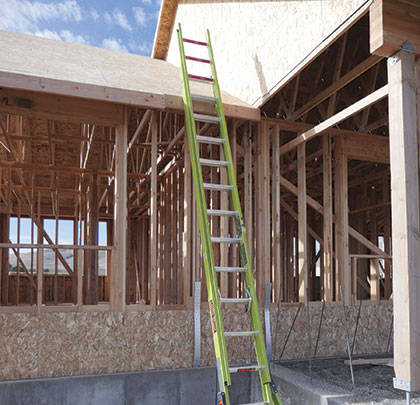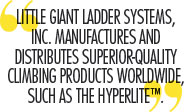In 2008, the CPSC estimated that more than 500,000 people were injured while using a ladder or stepstool. In 2010, the estimate rose to 724,000—that’s nearly 2,000 people injured every day. Experts estimate that 100 people will suffer a long-term or permanent disability each day. And, one person will die, every day.
Understanding how people actually use ladders, and more importantly, how they get injured while using ladders, is key to designing new, safer climbing products. Studying the numbers, the majority of ladder accidents fall into three categories: strains and sprains from handling heavy ladders, using the wrong type or size of ladder, and catastrophic falls from overreaching or improper setup.
HANDLING INJURIES
First, nearly 50 percent of reported injuries involving ladders are caused by the awkward size and weight of the ladder. The average 28-foot extension ladder weighs 65-75 pounds depending on the model. Some service industries have thousands of technicians, with many making more than 10 stops a day. That adds up to millions of ladder encounters a day with a heavy, hard-to-handle product. Every day, hundreds of people are injured because of the weight of their ladder. The easy solution to this problem is to make a lighter ladder. Advances in fiberglass technology have allowed Little Giant to produce the lightest fiberglass extension ladders in the world. This new material reduces the weight by up to 40 percent while increasing the stiffness by nearly 20 percent, giving you a lighter, stronger ladder that is still non-conductive.
WRONG TYPE, WRONG SIZE
Second, we use the wrong type or size of ladder for the job. Quite often, this problem is caused by the first problem. The right size ladder for the job is too heavy, so we grab a smaller one.
Choosing wrong type of ladder also causes issues. Workers sometimes use a stepladder in place of an extension ladder for the same reason, the stepladder is lighter. Although it may seem like a good idea, using the right ladder for the job will help prevent unnecessary accidents.
OVERREACHING
The third category (overreaching) is by far the most costly per incident, both in financial and human costs: falls from height due to overreaching or improper setup. These are the kinds of falls that change lives—or end them.
You train your people to keep their bodies between the side rails, but you know this doesn’t always happen. All too often, you see them stretch to reach that one last thing instead of climbing down and moving the ladder over. On many jobsites, it is nearly impossible to find a perfectly level setup for a ladder, so a brick or a board is used to build up the low side of the ladder. Aftermarket leg levelers can help, but they have two major problems. First, they add extra weight to an already heavy ladder (remember problem #1); and second, they do not add any extra stability to the ladder.
By reducing the weight of the ladder, we have been able to add new safety features like adjustable outriggers that open to double the width at the base increasing side-tip stability. These outriggers also level uneven surfaces, helping prevent catastrophic tip and fall accidents caused by overreaching. Even with the added safety, these ladders are lighter than standard ladders.
Two things—training and innovation—are going to help prevent injuries and save lives. The American Ladder Institute (ALI) has developed the best online ladder safety training available at www.laddersafetytraining.org. They also sponsor National Ladder Safety Month every March (www.laddersafetymonth.com). These efforts, combined with improvements in ladder design, like added stability and lighter weight, will help us get people home safely at the end of the day.
About the Author:
Dave Francis is an industry expert and thought leader in ladder safety training. Within the last year alone, he has been invited to provide on-site ladder safety training to companies coast-to-coast in fields ranging from airlines to construction, cable communications to space travel, entertainment to oil refining, manufacturing to alarm systems.
_________________________________________________________________________
Modern Contractor Solutions, December 2017
Did you enjoy this article?
Subscribe to the FREE Digital Edition of Modern Contractor Solutions magazine.




